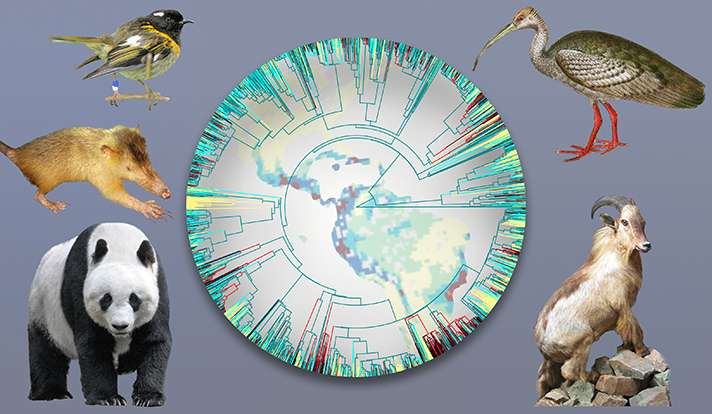May 25, 2017 report
Study of biodiversity suggests a small increase in size of protected areas could reap large rewards

(Phys.org)—A trio of researchers, two with Laboratoire d'Écologie Alpine in France and the other with Yale University has conducted an analysis of current parcels of land on our planet that offer protection for plants and animals and have found that just a few small increases in land allotment could produce a large positive influence on biodiversity on a global scale. In their paper published in the journal Nature, Laura Pollock, Wilfried Thuiller and Walter Jetz outline their study and why they believe that areas meant to protect biodiversity need to include more than just number of species.
Many countries throughout the world have set aside parcels of land to serve as havens for plants and animals—the hope is that by doing so, local wildlife can avoid extinction due to encroachment by human activities. Those that manage such areas tend to strive for rich biodiversity, which generally means providing for as many species as possible in a limited space. But the researchers with this new effort argue that conservation area managers might want to include species that represent evolutionary and functional diversity, as well. The first refers to species that are very unique, such as giant pandas, while the second refers to those that fill unique roles in their environment—beavers, for example, which build dams that create living spaces for many other species. But more importantly, they also suggest that setting aside just 5 percent more land area could result in large global gains in all three types of biodiversity.
To reach these conclusions, the researchers looked at a catalog of approximately 15,000 protected areas around the globe and their native mammals and birds, breaking the regions down by the types of biodiversity they supported. They found that just 25 percent of species biodiversity could be accounted for—and it was less than that for the other types of biodiversity. Then they looked at the impact of increasing the size of protected areas, and found that an increase of just 5 percent could result in tripling all types of biodiversity globally. They suggest that additional studies conducted at a more localized level could reveal which types of species could benefit most from a small increase in land size.

More information: Laura J. Pollock et al. Large conservation gains possible for global biodiversity facets, Nature (2017). DOI: 10.1038/nature22368
Abstract
Different facets of biodiversity other than species numbers are increasingly appreciated as critical for maintaining the function of ecosystems and their services to humans1, 2. While new international policy and assessment processes such as the Intergovernmental Science-Policy Platform on Biodiversity and Ecosystem Services (IPBES) recognize the importance of an increasingly global, quantitative and comprehensive approach to biodiversity protection, most insights are still focused on a single facet of biodiversity—species3. Here we broaden the focus and provide an evaluation of how much of the world's species, functional and phylogenetic diversity of birds and mammals is currently protected and the scope for improvement. We show that the large existing gaps in the coverage for each facet of diversity could be remedied by a slight expansion of protected areas: an additional 5% of the land has the potential to more than triple the protected range of species or phylogenetic or functional units. Further, the same areas are often priorities for multiple diversity facets and for both taxa. However, we find that the choice of conservation strategy has a fundamental effect on outcomes. It is more difficult (that is, requires more land) to maximize basic representation of the global biodiversity pool than to maximize local diversity. Overall, species and phylogenetic priorities are more similar to each other than they are to functional priorities, and priorities for the different bird biodiversity facets are more similar than those of mammals. Our work shows that large gains in biodiversity protection are possible, while also highlighting the need to explicitly link desired conservation objectives and biodiversity metrics. We provide a framework and quantitative tools to advance these goals for multi-faceted biodiversity conservation.
The researchers have created interactive web maps in the Map of Life project to accompany the study. They can be found at: mol.org/patterns/facets
Journal information: Nature
© 2017 Phys.org


















